________________
34
The Concept of Pañcasila in Indian Thought
a general code of conduct made by the samgha either for the maintenance of Samgha or for the individual morality, and non-indulgence in any deliberate trespassing of these rules is expected. This shows that sila is both internal and external, and mental and physical; besides, it is not only negative but positive as well.
Sila in fact consists of right speech, right action and right livelihood (sammāvācā, sammākammanā, sammājivā). Refraining from speaking falsehood, malacious words, harsh and frivolous talk is right speech. Right action means refraining from killing, stealing and misconduct. Right livelihood means refraining from earning livelihood by improper means, i. e. arts and crafts of laymen, astronomical forecasts, inter pretation of dreams, use of magical powers, etc. These in other words can be split up in five precepts or 'pancasila' of monks, nuns, and lay-people and also unordained novices. In Digha Nikāya silas have been enumerated as three, that is small, medium and great (cūla, majjhima and mahā) in relation to those of lay-people, unordained novices, and monks and nuns. This is where a discussion of all the five, eight or ten precepts of monks, nuns and lay people is found.
The five precepts are expected from every lay devotee of Buddhism. But the more faithful among the laymen, however, observe three more precepts. They thus observe the atthasilas (eight silas). The remaining three are : (1) vikāla bhojanā. veramaņi--not to take meals at odd times, (2) nacchagita vādita vikusadassana veramaņi-not to indulge in dances, music, etc., (3) malla-gandha-vilepaņa-veramaņi—not to use scents, perfumes, etc.; these are secondary precepts for the lay people. They are usually observed on the Uposatha days such as the eighth and the fourteenth of each fortnight and the full moon day and the moonless day. But these five and eight silas are called by Buddhaghosa as gahatthasilas; the strength of the silas observed is dependent on the mind, speech and action. A Bhikkhu observes the above mentioned
Jain Education International
For Private & Personal Use Only
www.jainelibrary.org




